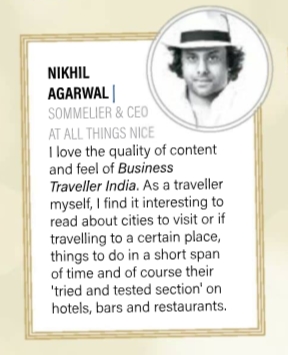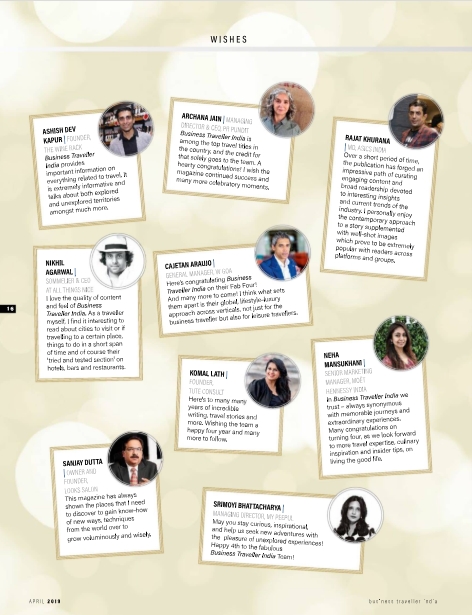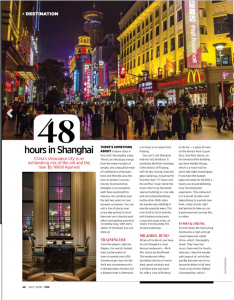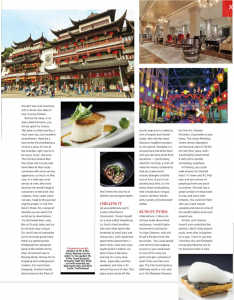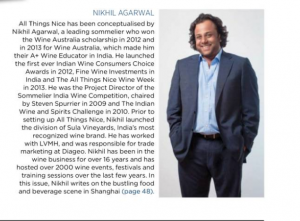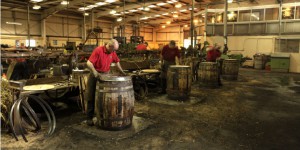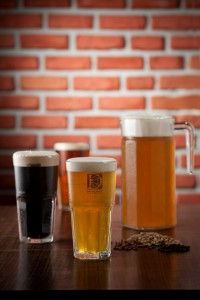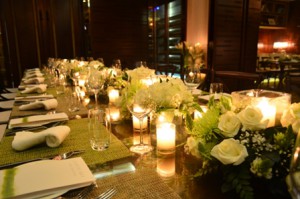Sommelier Nikhil Agarwal’s quote in Business Traveller’s 4th anniversary edition:
Tag Archives: sommelier
Mumbai Mirror – The shifting spirit of Mumbai by Nikhil Agarwal
Man’s World Magazine – 48 hours in Shanghai by Nikhil Agarwal
There’s something about modern cities in Asia that I thoroughly enjoy. There’s an infectious energy from the sheer number of people, and a beautiful mesh of traditional architecture, food and lifestyle, plus the best of western luxuries, brands, food and drink. Shanghai is no exception, and I have explored this massive city carefully over the last two years on two separate occasions. You can visit a ton of places over a two-day period (a lot of them are very close to each other) and getting around is incredibly easy, with every option of transport you can think of.
Training Day
From the airport, take the Maglev, the world’s fastest train, to the centre of town at speeds over 400 kilometres per hour for the thrill and convenience of it. It literally takes minutes, for a distance that is otherwise is an hour or so away from Pudong.
You can’t visit Shanghai and not visit the Bund. It overlooks the River Huangpu in the district of Pudong, with its sky-kissing, futuristic glass buildings, including the Oriental Pearl TV Tower and the Jin Mao Tower (what the locals refer to as the bottle opener building) on one side and old colonial buildings on the other. Both sides are equally eye catching in exactly opposite ways. The river itself is full of activity, with floating restaurants, cruise and cargo ships, all slowly moving along this ancient waterway.
Mr. & Mrs. Bund
When at the Bund, you have to visit Shanghai’s most famous restaurant — Mr.& Mrs. Bund, by Paul Pairet. This restaurant offers incredibly delicious French food, great cocktails and a brilliant wine and spirit list with a view of Pudong to die for — a glass of wine on the terrace here is pure bliss.

Interiors of Mr. & Mrs. Bund

Mr.& Mrs. Bund banquet
One floor above, on the terrace of the building, you have the Bar Rouge, which is a must-visit for some late night shenanigans. If you have the budget (approximately Rs 40,000 a head) you should definitely have the Ultraviolet experience. This restaurant is in a secret location and takes dining to a whole new level, using sounds, light and aromas to take you on a gastronomical journey like no other.
Food & Drink
Further down the road along the Bund is a high-end yet casual tapas bar called Unico, which I thoroughly loved. They have live music there and the food is delicious. I had the lobster with peanut oil, which has quickly become one of my favourite dishes of all time. I took a sip of their Malbec Cosmopolitan, which I thought was truly inventive, with a whole new take on how to enjoy Malbec.

Egg mushrooms and duck confit
Not too far away, in an area called Xintiandi, you will be spoilt for choice. This area is a little touristy, I must warn you, but excellent nevertheless. Head for a beer at the Pauline Bauhaus, or have a glass of vino at the wine bar right next to it for some ‘lucky’ red wine. The Chinese believe that the colour red is lucky and have taken to their lucky red wines with some serious aggression, so much so that now, in a relatively small period of time, they have become the world’s largest consumers of red wine. But I digress. If you want some live jazz, head to the jazz bar slightly ahead, or visit The Devil’s Share, for a range of whiskies as you watch the world go by down below. Try the famed Xiao Long Bao at Crystal Jade, and try to not burn your tongue. Oh, and if you’re looking for some seriously good steak, there is a spanking new Wolfgang Puk restaurant bang in the middle of this area. Connected here is Nanjing Road, famous for its shopping and underground markets. For world class shopping, head to Huahai (also known as the Paris of the Orient) for your fix of fashion and designer labels.

Truffle Bread

Black Cod Essential Soy
Chilling It
An area definitely worth a visit is the French Concession. I found myself on a road called Yong Kang Lu, that is lined on either side with what seems like hundreds of small bars and restaurants, with residential apartments above them. I don’t think I have ever seen anything like it before. Go down there in the early evening for a very slow drink , especially over the weekend, and take in its almost Goa sort of vibe. This place seems to be off the tourist map and is visited by tons of expats and hipster locals, who ride the most fabulous modified scooters on the planet. Shanghai is a serious food and drink town and you can have great food anywhere — I particularly liked Din Tai Fung, a chain of value for money restaurants that are scattered all around Shanghai and the rest of Asia. If you’re the adventurous kind, try the many street food options, that include duck tongue, insects, bamboo shoots and a variety of pork-based dishes.
Kung Fu Panda
Alternatively, it does not all have to be about food and booze. I would highly recommend visiting the Yu Yuan Gardens, with old King Fu Panda movie-like structures. You could spend a lot of time here walking around or you could head to one of the many tea spots and get a glimpse of what China was like eons ago.

Shanghai night life

Yu Yan garden
The City God temple is definitely worth a visit, and so is the Shanghai Museum for Fine Art Chinese Porcelain, if porcelain is your thing. The Urban Planning Centre shows Shanghai’s architectural plans in 3D for the next four years, and I would highly recommend a visit just to see the technology used here.
In Pudong, you could walk around the Oriental Pearl TV Tower and IFC Mall area and see swarms of people go from one place to another. The mall has a great number of restaurants on top, and some with terraces. You could sit there with your neck craned upwards and look at some of the world’s tallest structures around you.
All this, and I frankly haven’t even scratched the surface; I don’t think anyone could, even after living here for a year. I have to say that I love this city, and Shanghai has quickly become one of my favourite cities in Asia.
All Things Nice
All Things Nice or ATN is an Indian consultancy firm that specializes in luxury wine and spirits. All Things Nice was established in 2010 by Nikhil Agarwal and today has 262,000 members and organizes approximately 500 wine and spirit related experiences, annually. Based in Mumbai, the company works with large wineries, spirit and gourmet food companies, hotels and restaurants and large corporates.
Having diligently curated a rich list of corporates and consumers, All Things Nice plans to expand its portfolio to include Arts, Luxury Homes, Auto, Luxury Travel and Style.
Services:
For Restaurants, Bars, Hotel Chains, Modern Retails Stores and Airlines
- Menu Engineering
- Staff Training
- Marketing
- Beverage Program
For Global Wine & Spirit Companies
- On-ground marketing and sales support
- Market Intelligence
- Import, Distribution & Warehousing solutions
- Events and Launches
- Winery Setup
- Training for F&B team
For Corporates using wine, spirits and food as a medium
- Brand Launches
- Client Engagement Programs
- Client Acquisition Programs
- Employee Engagement
- Corporate Gifting
- Private Wine Labels
For Consumers
- Fine Dining Events
- Single Malt Tastings/Dinner
- Cognac Tastings
- Wine Tastings/ Wine Dinners
- Wine Festivals
- Consumer Training
- Private Tastings
- Vineyard Trips
- International Trade Fairs
‘How are Indian Wines perceived by other countries’- Food Hospitality World
Article from Food Hospitality World magazine by Sommelier Nikhil Agarwal.
To even write an article with this heading gives you some indication just how far we have come in such a short period of time. I am and have been an ardent supporter of the Indian wine industry for many years now having started my own journey almost 15 years ago with Sula Vineyards. Before I left I was in charge of Sula’s export market so I have been watching Indian wines grow overseas for sometime.
For anyone paying attention, the revolution-taking place in the wine industry is visible for all to see. To fairly summarize what’s happening with Indian wine internationally we first must first look at what’s happening with the industry domestically.
Things are not the same as when I joined the industry 15 years ago. At that time there were only three relevant wineries – Sula, Indage and Grovers. Three wineries do not make a market; as I remember Rajeev Samant stating that for the industry to grow we need to have more wineries with a focus on quality.
In the last seven odd years there has been a push on quality of wine due to many reasons. More wineries have been set up and therefore there is more competition. We now have a more aware consumer base that is getting to be more confident in judging a good wine from a bad one with conviction. They may not be aficionados or wine enthusiasts but are sure of what their likes or dislikes are without thinking that it’s them and not the wine which is the issue.
It’s only natural that quality a once abandoned virtue by now unsurprisingly defunct wineries is the buzz word of the handful of wineries looking to change things around.
Producers like Vallonne, a small winery with a mighty heart and an uncompromising stance of quality and Fratelli, with its deep pockets, business acumen and more importantly an understanding of wine making through its Italian partnership have created an array of quality wines in the midst of nowhere.
These wineries are now not only vying for consumer attention domestically but are aggressively looking at the international market. This is an interesting time for Indian wine.
All Things Nice hosted a dinner in Hong Kong with Eddie Mcdougal who I met when Discovery Travel & Living filmed the Indian leg of The Flying Wine Maker. The feedback I got both before and after the dinner was astonishing. Before the guests tasted the wine they confided in me that there were curious but had absolutely no expectations that Indian wine was just as much as a puzzle to them as India was.
But when the wines were served they could not believe it. The wines from Grovers, Sula, Fratelli, Charosa, Myra and Vallonne were all appreciated so much that two of the wineries found themselves on their way into the markets of Hong Kong and China through an importer who attended the dinner.
The fact is that India is making good wine but we haven’t managed to make an industry of it as yet. Indian wine requires itself to make giant strides in the international market to be distinguished as a category. Yes Sula, Grovers and now Fratelli continue to increase their presence internationally but lots more needs to be done. More wineries need to be out there creating Brand India.
So while those in the know have looked at India’s burgeoning wine market and understand its quality levels, the everyday wine consumer internationally has little knowledge that India even makes wine. Within the trade internationally there is a buzz that is beginning to develop. For example I have been invited to Shanghai to speak about the Indian wine industry at SIAL in May 2015, while Fratelli has been chosen as a showcase project at Hannover Messe 2015 with their wines being the official wine at the Indian pavilion. Recently Rajeev Samant spoke at the Masters of Wine symposium. It takes time to build a brand and as you can see, the efforts are on.
You also don’t need to have the wines available internationally to understand what foreign palates prefer. The number of people from all over the world coming to cities like Mumbai, Delhi/Gurgaon and Bangalore gives us enough of a pool to understand whether we measures up and the answer is yes because even our own Indian consumers who swear by the imported stuff wouldn’t necessarily be able to tell the difference between an Indian and imported in a blind tasting.
For an industry that did not exist more than 20 years ago to where we are today, the journey is quite impressive. There is yet a long way to go and perhaps we should take this question up again in the next 5 years. Perhaps we can be bolder and aggressive in our international approach collectively to get the ball rolling faster.
One thing is for sure, either we need to have one or two wineries that come up with break though quality that gets the worlds attention (like what Yamazaki has done for the Japanese whisky profile) or we need to raise the game collectively through all relevant Indian wineries. Indian wineries are adding awards left right and centre at global wine competitions and since wine enthusiasts tend to be inclined on discovering new wines and new regions I predict that Indian wine will slowly seep into international consumer mindsets as time goes on as long as we play our cards right.
Speyside, Scotland
Playing host to over 50 distilleries, Speyside has the greatest concentration of malt whisky producers compared to any other whisky producing region of Scotland, including the Highlands (of which Speyside is a sub-region), the Lowlands or the island of Islay.
As a style, Speyside whiskies are usually lighter and sweeter than other Scotch single malts. As they grow older, they develop body. Typical flavour characteristics include green apple, vanilla, oak, dried fruit and nutmeg.
The Speyside region has the vast majority of all the Scotch distilleries, and thus there is a great variation. Aside from the lighter, honeyed single malts, there are also a small group of distilleries which produce a heavily sherried style Speyside whisky. Glenfarclas and The Macallan, for example, produce big bodied whiskies, The Glenlivet and Glenfiddich distilleries produce the most classic, typical Speyside drams, and both are world famous.
York Chenin Blanc 2014, India
Doolally
I along with thousands of others seem to be immediately hooked. I’d probably go as far as saying we are addicted to Doolally. Who can blame u? It’s located in a nice quite street in Bandra, it’s very casual, always has a buzz, the beer is truly unbelievable, the grub is good and the price offers incredible value for money. Rs 250 for 330ml glass of world class beer just feels so right.
Since it opened I find myself dreaming about their beers and land up visiting on average of at least thrice a week. Sometimes it’s just for 2 quick pints. Sometimes it’s just because I’ve got off the sea link on my way home in the evening . I’ve even got one of the member mugs with my name on it.
The beer is undoubtedly the star of the show, with a variety of offerings and each of them with their own unique flavors, they keep you coming back for more. My favourite would have to be the Stout, though their Hefeweizen, Belgium wit beer, Belgium Farmhouse ale and their Weizenbock are excellent. There are more and I like them all frankly. Haven’t tried their cider and don’t intend to but it does seem popular as well. To get the uninitiated up to speed they are happy to pour tasting portions so that people can sample and then place an order.
They and the other brewpubs like The White Owl along with Gateway Brewing have upped the quality levels of beer available in Mumbai so dramatically that I think Kingifsher and the like will have to change their game if they want to retain quality oriented consumers.
The food though not the centre of attraction is actually very good and also different which makes it interesting. Scotch eggs, Kerala prawns, ghee chicken roast, the batter fried bombay duck all really good and all perfect to go with their beers.
No one can deny that there is a drink revolution going on in India, Doolally gives us an opportunity to drink world class delicious beer and not the crap that we’ve been subjected to all this while at prices that are affordable. Well at least since before Gateway came along.
At Doolally suddenly conversations about different kinds of beer and understanding their origins can be heard from every table and that’s something right ? Even though we’ve been drinking beer all this while we never really bothered to know the differences until now.
But Doolally has created another revolution, one that I have been watching closely. The revolution I’m talking about is the social revolution when it comes to drinking that Doolally seems to have set a tone for. I find that people are comfortable getting their kids ( very young kids as well) and even their pets to Doolally. Doolally has somehow created a vibe that is very welcoming, almost like a German beer garden. It’s this sort of vibe, openness to drinking a glass of beer that India needs. Going out for food and a couple of pints of beer if handled responsibly could also be a family affair.
Nowhere else do I see this phenomenon. It’s changing things, you see some people wondering ( My wife and I go with our twins every sunday) what we’re doing but then I also see them changing their stance when they see us having a good time. The kids freak out on the fries and we sip on a beer or two and spend our time together. Really nothing wrong with that.
By Nikhil Agarwal, Sommelier and Director at All Things Nice
Our Iconic Cloudy Bay Wine Dinner
 All Things Nice and Chandon India hosted an iconic dinner with Cloudy Bay, New Zealand’s most famous winery, at the Four Seasons Hotel Mumbai. Over 35 guests enjoyed an evening of fabulous wine paired with an outstanding menu by Chef Chaitanya Sharma at The Kitchen, a quaint little space that allowed everyone to be in close quarters to the live action in the kitchen.
All Things Nice and Chandon India hosted an iconic dinner with Cloudy Bay, New Zealand’s most famous winery, at the Four Seasons Hotel Mumbai. Over 35 guests enjoyed an evening of fabulous wine paired with an outstanding menu by Chef Chaitanya Sharma at The Kitchen, a quaint little space that allowed everyone to be in close quarters to the live action in the kitchen.
The wines served were stars from the Cloudy Bay portfolio – Sauvignon Blanc, Chardonnay, Pinot Noir and finally Te Koko, a unique style of Sauvignon Blanc. Some of Chef Sharma’s creations included the Sous Vide Tiger Prawns, Truffled Potato Gnocchi and the Roast Lamb Loin in Butternut Squash Puree. In our opinion Cloudy Bay offers super high quality wines that arefull of freshness and finesse and you cannot but help fall in love with them. We weren’t surprised that this evening turned out to be such a great success!
Here is a look at the outstanding menu we enjoyed
Pass Around Canapés
Asparagus Fricassee In Mini Bouchees (V)
or
Goat Cheese And Walnut With California Grape (V)
or
Home Cured Salmon In Rye Baguette
or
Smoked Chicken And Green Apple On Whole Wheat Crisp
Cloudy Bay Sauvignon Blanc 2012, Marlborough, New Zealand
First Course
Roasted Baby Beets With Arugula, Shaved Fennel, Pommery Honey Dressing (V)
or
Sous Vide Tiger Prawns With Cauliflower Puree And Pickled Root Vegetables
or
Cloudy Bay Chardonnay 2012, Marlborough, New Zealand
Second Course
Truffled Potato Gnocchi, Toasted Pinenuts, BeurreNoisette (V)
or
Roast Lamb Loin, Butternut Squash Puree, Glazed Confit Carrots, Thyme Jus
or
Cloroudy Bay Pinot Noir 2012, Marlborough, New Zealand
Third Course
Platter of Brie, gruyere and chevre with wheat crisps
Cloudy Bay Te Koko 2011, Marlborough, New Zealand
Petit Fours
Nikhil Agarwal interviews Albert Adria
Nikhil interviews Albert Adria, one of the most acclaimed chefs in the world and brother of Ferran at their new restaurant- Tickets.
I was in Barcelona recently, as a pit stop after a visit to Priorat, a truly beautiful wine region in Spain not too far from the city. This region produces beautiful wines that are gaining popularity around the world, they are also some of Spain’s most expensive wine offerings. While in Barcelona I was intent to eat at Tickets which is the famed brothers – Ferran and Albert Adria’s new restaurant after closing the legendary and path breaking El Bulli.
El Bulli was considered until very recently the best restaurant in the world but perhaps only not the best anymore because the brothers closed the restaurant for good. I tugged and pulled, bullied and pleaded and succeeded in getting myself a reservation at Tickets. This restaurant normally has a two month plus waiting list and to add to my good fortune, as a bonus, I got to spend time with Chef Albert Adria himself.
What was the Idea behind Tickets?
We wanted to create a traditional yet sophisticated take on the regular Spanish tapas bar. To take the concept of the everyday tapas bar and make it more fine dining yet retaining the casualness of a tapas bar.
Do you plan to open any restaurants outside of Barcelona?
We have a lot of opportunities today to open restaurants all over the world but at the moment we do not want to. We may open a restaurant in London. We don’t have the team to open up more restaurants.
Your fascination with food started with?
I started working in the kitchen when I was 15 years old, I started working in the kitchen only because I needed to work but soon I fell in love with food and the kitchen.
What’s the secret to opening amazing restaurants?
When we closed El Bulli, we were had a lot of experience and a great team. This team allows us to take all the ideas that we have in our minds and make it a reality. We understand what people want.
Why did you close El Bulli ?
El Bulli was a train running at a very high speed and it was like we had to keep feeding the train to ensure that it stayed at that speed. At the end we were just tired.
This train allowed us to learn a lot, we became known around the world and it is the best moments in my life and the life of Ferran. We are the same team but we are older and with families, it was time to move on. We also wanted to close El Bulli at its peak.
Do you have the same ways of thinking with Ferran ?
We speak the same language but have different personalities. We discuss a lot and find middle ground.
In which direction is Spanish gastronomy going?
It is a contradiction, on one hand we want to be avant- garde and on the other we want to hold onto tradition.
What’s new in Spanish cuisine?
It is not easy to find something new now but perhaps we can see what we can bring back from history. Things have changed; the world is a much smaller place now. Now I can get ingredients from India, South America and Africa for example. Thanks to the internet I can see the menu’s of restaurants all over the world. Information is easy and to take new directions in food or borrow from different cultures is on our fingertips.
Do you believe in using ingredients from all over the world ?
Tickets is 95% Spanish and besides a few things here or there we are proud to showcase Catalan cuisine using the finest local ingredients.
Could you explain Molecular Gastronomy?
Unfortunately I cannot explain it. I was talking to a journalist the first time we used nitrogen and somehow we got tagged as purveyors of molecular gastronomy. We wrote a letter to the entire media saying that we do not believe in molecular gastronomy, all we believe is in a good kitchen and a bad kitchen. The customer is not interested in molecular gastronomy. I may give him a variation of an olive but if he doesn’t like the taste of that olive we have failed. At the end every cuisine of the world depends on only one thing, the quality of the ingredient.
To make a great olive recipe you need to ensure you have the best olives, we make sure we get the best and that’s it. For the customer, the experience is just 2 seconds; we only have those 2 seconds to give them a burst of flavours.
We serve customers from around the world, which is difficult, 50 % of our customers are foreigners, we want to make a menu for everybody. So we cannot say that we do or understand what molecular gastronomy is.
When I was on my way to Tickets I was excited, finally I was going to have the Adria experience. Do you realize the level of impact you have had on people who love food?
The entire team knows that there are people waiting to have dinner or lunch at our restaurant and we take this responsibility very seriously. We want to make sure that we do the best with every lunch or dinner seating.
What is the reason behind calling the restaurant Tickets?
The area where Tickets is located was like Broadway so we called it Tickets. The doors are like a cinema door. You come in for a show, for an experience.
You use emotion in food, my ice cream that I ordered was served in a way that reminded me of my childhood. ( It was served by someone riding an icecream cart to my table and ringing the cycle bell to inform me that it had arrived).
For us the most important thing is the food. We can play with emotion, we can create flash backs to when make people were young, but in the end the quality of the food is the most important to me. And really that’s all. Everything else, emotion, changing shapes and sizes is important but not as important as the food. We should not only do play food but also serious food. I am serious when I am fooling around with food.
As told to Nikhil Agarwal, Director & Sommelier – All Things Nice

